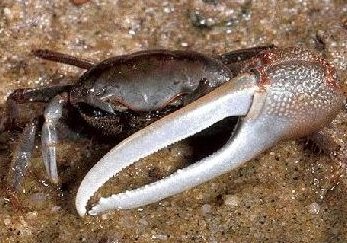|
Calappa Japonica
''Calappa japonica'', also known as the Japanese shame-faced crab, is a marine species of box crab in the family Calappidae. Originally found in the waters around Japan, more recently it has been found in Africa, the Red Sea and Western Australia. Description ''Calappa japonica'' is a large crab, and has a yellow and red colouration. The length of carapace is approximately .65 times the width, with a tuberculated surface. Seven sharp teeth are located around the margins of each clypeiform expansion. Distribution and habitat This species was first discovered in Tokyo Bay, Japan. It is now known to occur in regions as far away as Africa and Western Australia, and lives in waters up to deep. as well as being found in the Red Sea. Behaviour and diet This crab is a predator, and feeds on invertebrates such as other crabs, as well as oysters and snails. It has a specially adapted right pincer which it uses to break open snail's shells. There is a large accessory tooth located at t ... [...More Info...] [...Related Items...] OR: [Wikipedia] [Google] [Baidu] |
Arnold Edward Ortmann
Arnold Edward Ortmann (April 8, 1863 – January 3, 1927) was a Prussian-born United States naturalist and zoologist who specialized in malacology. Biography Ortmann was born in Magdeburg, Prussia on April 8, 1863. A student of Ernst Haeckel, he graduated from the University of Jena in 1885 with a Ph.D.; he had also studied at the University of Kiel and the University of Strasbourg. From 1886 on, he worked as an instructor at the University of Strasbourg. Together with Haeckel, he participated in an expedition to Zanzibar in 1890/91. Three years later, he emigrated to the United States, where he got a post as the curator of the department of invertebrate paleontology at Princeton University. In 1899, he participated in the Peary Relief expedition, and one year later, he was naturalized as a U.S. citizen. In 1903, he moved to Pittsburgh. He became the curator of invertebrate zoology at the Carnegie Museum and from 1910 on, he was professor of physical geography at the Univers ... [...More Info...] [...Related Items...] OR: [Wikipedia] [Google] [Baidu] |
Western Australian Museum
The Western Australian Museum is a statutory authority within the Culture and the Arts Portfolio, established under the ''Museum Act 1969''. The museum has six main sites. The state museum, now known as WA Museum Boola Bardip, officially re-opened on 21 November 2020 in the Perth Cultural Centre. The other sites are: the WA Maritime Museum and WA Shipwrecks Museum in Fremantle, the Museum of the Great Southern in Albany, the Museum of Geraldton in Geraldton, and the Museum of the Goldfields in Kalgoorlie-Boulder. History Established in 1891 in the Old Perth Gaol, it was known as the Geological Museum and consisted of geological collections. In 1892, ethnological and biological exhibits were added, and in 1897, the museum officially became the Western Australian Museum and Art Gallery. The museum employed collectors to obtain series of specimens; Tunney ventured across the state from 1895 to 1909 obtaining animals and, later, the tools and artefacts of the indigenous inhabi ... [...More Info...] [...Related Items...] OR: [Wikipedia] [Google] [Baidu] |
Calappa (crab)
''Calappa'' is a genus of crabs known commonly as box crabs or shame-faced crabs. The name ''box crab'' comes from their distinctly bulky carapace, and the name ''shame-faced'' is from anthropomorphism, anthropomorphising the way the crab's chela (organ), chelae (claws) fold up and cover its face, as if it were hiding its face in shame. Species There are 43 extant species in the genus: *''Calappa acutispina'' Lai, Chan & Ng, 2006 *''Calappa africana'' Lai & Ng, 2006 *''Calappa bicornis'' Miers, 1884 *''Calappa bilineata'' Ng, Lai & Aungtonya, 2002 *''Calappa calappa'' (Linnaeus, 1758) *''Calappa capellonis'' Laurie, 1906 *''Calappa cinerea'' Holthuis, 1958 *''Calappa clypeata'' Borradaile, 1903 *''Calappa conifera'' Galil, 1997 *''Calappa convexa'' Saussure, 1853 *''Calappa dumortieri'' Guinot, 1962 *''Calappa exanthematosa'' Alcock & Anderson, 1894 *''Calappa flammea'' (Herbst, 1794) *''Calappa galloides'' Stimpson, 1859 *''Calappa gallus'' (Herbst, 1803) *''Calappa granulata'' ... [...More Info...] [...Related Items...] OR: [Wikipedia] [Google] [Baidu] |
Family (biology)
Family ( la, familia, plural ') is one of the eight major hierarchical taxonomic ranks in Linnaean taxonomy. It is classified between order and genus. A family may be divided into subfamilies, which are intermediate ranks between the ranks of family and genus. The official family names are Latin in origin; however, popular names are often used: for example, walnut trees and hickory trees belong to the family Juglandaceae, but that family is commonly referred to as the "walnut family". What belongs to a family—or if a described family should be recognized at all—are proposed and determined by practicing taxonomists. There are no hard rules for describing or recognizing a family, but in plants, they can be characterized on the basis of both vegetative and reproductive features of plant species. Taxonomists often take different positions about descriptions, and there may be no broad consensus across the scientific community for some time. The publishing of new data and opini ... [...More Info...] [...Related Items...] OR: [Wikipedia] [Google] [Baidu] |
Calappidae
Calappidae is a family of crabs containing 16 genera, of which 7 are only known as fossils: *''Acanthocarpus'' Stimpson, 1871 *'' Calappa'' Weber, 1795 *† '' Calappella'' Rathbun, 1919 *† '' Calappilia'' A. Milne-Edwards, 1873 *'' Calappula'' Galil, 1997 *'' Cryptosoma'' Brullé, 1839 *'' Cycloes'' De Haan, 1837 *'' Cyclozodion'' Williams & Child, 1989 *''Mursia'' A. G. Desmarest, 1823 *† '' Mursilata'' C.-H. Hu & Tao, 1996 *† '' Mursilia'' Rathbun, 1918 *† '' Mursiopsis'' Ristori, 1889 *'' Paracyclois'' Miers, 1886 *'' Platymera'' H. Milne Edwards, 1837 *† '' Stenodromia'' A. Milne-Edwards, 1873 *† ''Tutus'' Collins ''in'' Collins, Portell & Donovan, 2009 Fossils within this family can be found in sediment of Europe, United States, Mexico, Central America, Australia and Japan from Cretaceous The Cretaceous ( ) is a geological period that lasted from about 145 to 66 million years ago (Mya). It is the third and final period of the Mesozoic Era, as well as the ... [...More Info...] [...Related Items...] OR: [Wikipedia] [Google] [Baidu] |
Tokyo Bay
is a bay located in the southern Kantō region of Japan, and spans the coasts of Tokyo, Kanagawa Prefecture, and Chiba Prefecture. Tokyo Bay is connected to the Pacific Ocean by the Uraga Channel. The Tokyo Bay region is both the most populous and largest industrialized area in Japan. Names In ancient times, Japanese knew Tokyo Bay as the . By the Azuchi–Momoyama period (1568–1600) the area had become known as after the city of Edo. The bay took its present name in modern times, after the Imperial court moved to Edo and renamed the city Tokyo in 1868. Geography Tokyo Bay juts prominently into the Kantō Plain. It is surrounded by the Bōsō Peninsula in Chiba Prefecture to the east and the Miura Peninsula in Kanagawa Prefecture to the west. The shore of Tokyo Bay consists of a diluvial plateau and is subject to rapid marine erosion. Sediments on the shore of the bay make for a smooth, continuous shoreline. Boundaries In a narrow sense, Tokyo Bay is the area north of ... [...More Info...] [...Related Items...] OR: [Wikipedia] [Google] [Baidu] |
Japan
Japan ( ja, 日本, or , and formally , ''Nihonkoku'') is an island country in East Asia. It is situated in the northwest Pacific Ocean, and is bordered on the west by the Sea of Japan, while extending from the Sea of Okhotsk in the north toward the East China Sea, Philippine Sea, and Taiwan in the south. Japan is a part of the Ring of Fire, and spans Japanese archipelago, an archipelago of List of islands of Japan, 6852 islands covering ; the five main islands are Hokkaido, Honshu (the "mainland"), Shikoku, Kyushu, and Okinawa Island, Okinawa. Tokyo is the Capital of Japan, nation's capital and largest city, followed by Yokohama, Osaka, Nagoya, Sapporo, Fukuoka, Kobe, and Kyoto. Japan is the List of countries and dependencies by population, eleventh most populous country in the world, as well as one of the List of countries and dependencies by population density, most densely populated and Urbanization by country, urbanized. About three-fourths of Geography of Japan, the c ... [...More Info...] [...Related Items...] OR: [Wikipedia] [Google] [Baidu] |
Red Sea
The Red Sea ( ar, البحر الأحمر - بحر القلزم, translit=Modern: al-Baḥr al-ʾAḥmar, Medieval: Baḥr al-Qulzum; or ; Coptic: ⲫⲓⲟⲙ ⲛ̀ϩⲁϩ ''Phiom Enhah'' or ⲫⲓⲟⲙ ⲛ̀ϣⲁⲣⲓ ''Phiom ǹšari''; Tigrinya: ቀይሕ ባሕሪ ''Qeyih Bahri''; ) is a seawater inlet of the Indian Ocean, lying between Africa and Asia. Its connection to the ocean is in the south, through the Bab el Mandeb strait and the Gulf of Aden. To its north lie the Sinai Peninsula, the Gulf of Aqaba, and the Gulf of Suez (leading to the Suez Canal). It is underlain by the Red Sea Rift, which is part of the Great Rift Valley. The Red Sea has a surface area of roughly 438,000 km2 (169,100 mi2), is about 2250 km (1398 mi) long, and — at its widest point — 355 km (220.6 mi) wide. It has an average depth of 490 m (1,608 ft), and in the central ''Suakin Trough'' it reaches its maximum depth of . The Red Sea also has exten ... [...More Info...] [...Related Items...] OR: [Wikipedia] [Google] [Baidu] |
Journal Of Natural History
The ''Journal of Natural History'' is a scientific journal published by Taylor & Francis focusing on entomology and zoology. The journal was established in 1841 under the name ''Annals and Magazine of Natural History'' (''Ann. Mag. Nat. Hist.'') and obtained its current title in 1967. The journal was formed by the merger of the ''Magazine of Natural History'' (1828–1840) and the ''Annals of Natural History'' (1838–1840; previously the ''Magazine of Zoology and Botany'', 1836–1838) and '' Loudon and Charlesworth's Magazine of Natural History''. In September 1855, the ''Annals and Magazine of Natural History'' published "On the Law which has Regulated the Introduction of New Species", a paper which Alfred Russel Wallace had written while working in the state of Sarawak on the island of Borneo in February of that year. [...More Info...] [...Related Items...] OR: [Wikipedia] [Google] [Baidu] |
Chela (organ)
A chela ()also called a claw, nipper, or pinceris a pincer (biology), pincer-like organ at the end of certain limbs of some arthropods. The name comes from Ancient Greek , through New Latin '. The plural form is chelae. Legs bearing a chela are called chelipeds. Another name is ''claw'' because most chelae are curved and have a sharp point like a claw. Chelae can be present at the tips of arthropod legs as well as their pedipalps. Chelae are distinct from spider chelicerae in that they do not contain venomous glands and cannot distribute venom. See also * Pincer (biology) * Pincer (tool) References Arthropod anatomy {{Arthropod-anatomy-stub ... [...More Info...] [...Related Items...] OR: [Wikipedia] [Google] [Baidu] |
Calappoidea
Calappoidea is a superfamily of crabs comprising the two families Calappidae and Matutidae. The earliest fossils attributable to the Calappoidea date from the Aptian The Aptian is an age in the geologic timescale or a stage in the stratigraphic column. It is a subdivision of the Early or Lower Cretaceous Epoch or Series and encompasses the time from 121.4 ± 1.0 Ma to 113.0 ± 1.0 Ma (million years ago), a .... References External links * Crabs Aptian first appearances Taxa named by Henri Milne-Edwards Arthropod superfamilies Extant Aptian first appearances {{crab-stub ... [...More Info...] [...Related Items...] OR: [Wikipedia] [Google] [Baidu] |
Crustaceans Of The Indian Ocean
Crustaceans (Crustacea, ) form a large, diverse arthropod taxon which includes such animals as decapods, seed shrimp, branchiopods, fish lice, krill, remipedes, isopods, barnacles, copepods, amphipods and mantis shrimp. The crustacean group can be treated as a subphylum under the clade Mandibulata. It is now well accepted that the hexapods emerged deep in the Crustacean group, with the completed group referred to as Pancrustacea. Some crustaceans (Remipedia, Cephalocarida, Branchiopoda) are more closely related to insects and the other hexapods than they are to certain other crustaceans. The 67,000 described species range in size from '' Stygotantulus stocki'' at , to the Japanese spider crab with a leg span of up to and a mass of . Like other arthropods, crustaceans have an exoskeleton, which they moult to grow. They are distinguished from other groups of arthropods, such as insects, myriapods and chelicerates, by the possession of biramous (two-parted) limbs, and by their ... [...More Info...] [...Related Items...] OR: [Wikipedia] [Google] [Baidu] |




